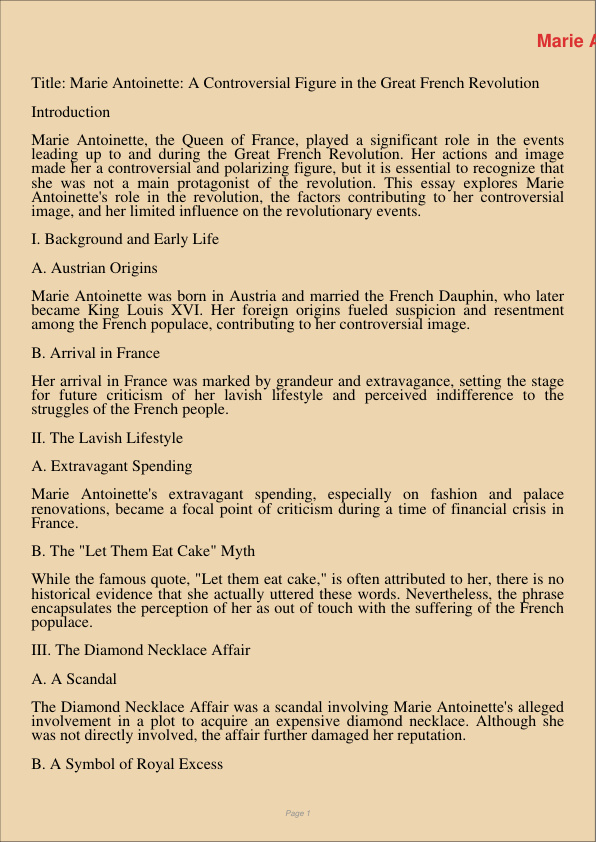
Title: Marie Antoinette: A Controversial Figure in the Great French Revolution
Introduction
Marie Antoinette, the Queen of France, played a significant role in the events leading up to and during the Great French Revolution. Her actions and image made her a controversial and polarizing figure, but it is essential to recognize that she was not a main protagonist of the revolution. This essay explores Marie Antoinette’s role in the revolution, the factors contributing to her controversial image, and her limited influence on the revolutionary events.
I. Background and Early Life
A. Austrian Origins
Marie Antoinette was born in Austria and married the French Dauphin, who later became King Louis XVI. Her foreign origins fueled suspicion and resentment among the French populace, contributing to her controversial image.
B. Arrival in France
Her arrival in France was marked by grandeur and extravagance, setting the stage for future criticism of her lavish lifestyle and perceived indifference to the struggles of the French people.
II. The Lavish Lifestyle
A. Extravagant Spending
Marie Antoinette’s extravagant spending, especially on fashion and palace renovations, became a focal point of criticism during a time of financial crisis in France.
B. The “Let Them Eat Cake” Myth
While the famous quote, “Let them eat cake,” is often attributed to her, there is no historical evidence that she actually uttered these words. Nevertheless, the phrase encapsulates the perception of her as out of touch with the suffering of the French populace.
III. The Diamond Necklace Affair
A. A Scandal
The Diamond Necklace Affair was a scandal involving Marie Antoinette’s alleged involvement in a plot to acquire an expensive diamond necklace. Although she was not directly involved, the affair further damaged her reputation.
B. A Symbol of Royal Excess
The scandal reinforced the image of Marie Antoinette as a symbol of royal extravagance and corruption, exacerbating public discontent.
IV. Limited Political Influence
A. Her Influence on Louis XVI
Marie Antoinette’s influence on her husband, King Louis XVI, was not as significant as the influence of other advisors and political figures, such as ministers and courtiers.
B. A Target of Scapegoating
While she was often blamed for the monarchy’s failures, she had limited political power and was used as a scapegoat for deeper systemic issues that led to the revolution.
V. Her Tragic Fate
A. Imprisonment and Execution
Following the revolution, Marie Antoinette and Louis XVI were imprisoned. Ultimately, she faced a trial and was executed by guillotine in 1793, marking a tragic end to her life.
B. A Symbol of the Old Regime
Her execution symbolized the end of the old regime and the monarchy, but it also represented the extremes to which the revolution had gone.
Conclusion
Marie Antoinette was indeed a controversial figure during the Great French Revolution, primarily due to her extravagant lifestyle, foreign origins, and perceived indifference to the suffering of the French people. However, it is essential to recognize that she was not one of the main protagonists of the revolution. While her actions and image contributed to the revolution’s dynamics, her influence on political events and decisions was limited. Marie Antoinette’s tragic fate and the symbolism attached to her execution serve as a poignant reminder of the turbulent and transformative nature of the Great French Revolution.
「真诚赞赏,手留余香」
真诚赞赏,手留余香
使用微信扫描二维码完成支付
